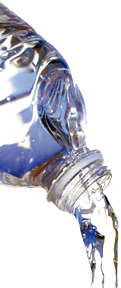Implementing a simple strategy of cardio after weight training will also have a significant positive impact on preventing fatigue and turbo-charging fat loss. This capitalizes on the hormone optimization principle of surging growth hormone and testosterone (yes, this concept applies to women, too) to accelerate fat loss and increase lean muscle tone.
3. Keep Yourself Hydrated
Did you know that being dehydrated makes you fatter? Why? Because muscle glycogen (sugar energy created from ingested carbohydrates)is stored along with water. For every gram of glycogen in the muscle, there should be three of water. Dehydration forces glucose to remain in the bloodstream instead of muscle until it reaches the liver for overflow storage. When the liver is full, the glycogen (sugar) has no place to go but your fat cells. Not good!
Your body is predominantly made up of water. It doesn't look that way in the mirror, but I assure you, without water you'd be nothing but a pile of assorted amino acids, minerals and some fatty acids. If we were to consider a single human cell, we'd be looking at a molecular structure that's between 70-85 percent water. Water is the primary component of blood. Water transports oxygen throughout the body.
 In short, water is an essential nutrient and perhaps the most neglected nutrient among individuals attempting to figure out "the best diet." When you perspire, you lose water; thus, it becomes even more vital for anyone committed to an intense exercise program. While the old, but unsubstantiated rule of eight glasses per day has held up just fine, multiplying your weight by .55 will give you a pretty good estimate of the ounces of water an exerciser should consume in a day. If you live in a warm climate and/or you're in a hot environment all day, be it outdoor construction or fueling an indoor furnace, you should make a concerted effort to increase your intake a bit higher.
In short, water is an essential nutrient and perhaps the most neglected nutrient among individuals attempting to figure out "the best diet." When you perspire, you lose water; thus, it becomes even more vital for anyone committed to an intense exercise program. While the old, but unsubstantiated rule of eight glasses per day has held up just fine, multiplying your weight by .55 will give you a pretty good estimate of the ounces of water an exerciser should consume in a day. If you live in a warm climate and/or you're in a hot environment all day, be it outdoor construction or fueling an indoor furnace, you should make a concerted effort to increase your intake a bit higher.
If you don't want to do all this math and measure ounces, I suggest you always have water with you. A bottle of spring water should be fine. Sipping it throughout the day, even if you are not experiencing thirst, can act as a valuable step in helping to mobilize fat and keep cells healthy.
4. Plan Your Work and Work Your Plan
How can you hit a target you can't even see? You must set your goals and then document your progress via a journal, computer or cell phone application. This is the only verifiable way you can determine what does and does not work over time. Write down everything, from what you eat to when you eat, training programs, how you felt during and after workouts, etc. Take pictures of yourself as you progress to attach the visible senses to your goal.
 Is this a lot of work? Yes! But how badly do you want to reach your goal? This is where the rubber meets the road and keeping a journal separates the serious from the dabblers.
Is this a lot of work? Yes! But how badly do you want to reach your goal? This is where the rubber meets the road and keeping a journal separates the serious from the dabblers.
Everyone who has ever achieved any success in this world has first had a plan; something that helped guide them in the right direction. We need a plan in order to see beyond "square one." There's tomorrow, a week from now, a month from now, a year from now and even longer than that – and if you formulate your action plan for getting into shape now, every day you'll get that much closer. A plan also clarifies more than just what you want to do; it clarifies what you have been doing, and is a valuable cross-referencing tool for adjustments in your methods and process. That way, you keep improving. This is true for exercise and diet. Outline a plan that includes what you want to do, what changes you must make to do it, and what the end result will be if you follow it. In fact, a diet will outline what you can and cannot do in order to meet your goal; both on a daily basis and in a general sense. Without this group of signposts on your way, how could you possibly have any direction?

